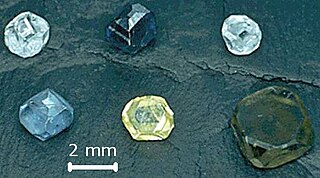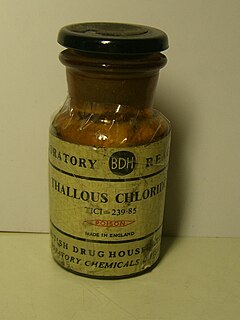Related Research Articles

Photoluminescence is light emission from any form of matter after the absorption of photons. It is one of many forms of luminescence and is initiated by photoexcitation, hence the prefix photo-. Following excitation various relaxation processes typically occur in which other photons are re-radiated. Time periods between absorption and emission may vary: ranging from short femtosecond-regime for emission involving free-carrier plasma in inorganic semiconductors up to milliseconds for Phosphorescence processes in molecular systems; and under special circumstances delay of emission may even span to minutes or hours.
Photoconductivity is an optical and electrical phenomenon in which a material becomes more electrically conductive due to the absorption of electromagnetic radiation such as visible light, ultraviolet light, infrared light, or gamma radiation.

In materials that exhibit antiferromagnetism, the magnetic moments of atoms or molecules, usually related to the spins of electrons, align in a regular pattern with neighboring spins pointing in opposite directions. This is, like ferromagnetism and ferrimagnetism, a manifestation of ordered magnetism.

Cadmium arsenide (Cd3As2) is an inorganic semimetal in the II-V family. It exhibits the Nernst effect.

Auxetics are structures or materials that have a negative Poisson's ratio. When stretched, they become thicker perpendicular to the applied force. This occurs due to their particular internal structure and the way this deforms when the sample is uniaxially loaded. Auxetics can be single molecules, crystals, or a particular structure of macroscopic matter. Such materials and structures are expected to have mechanical properties such as high energy absorption and fracture resistance. Auxetics may be useful in applications such as body armor, packing material, knee and elbow pads, robust shock absorbing material, and sponge mops.

Indium nitride (InN) is a small bandgap semiconductor material which has potential application in solar cells and high speed electronics.

Imperfections in the crystal lattice of diamond are common. Such crystallographic defects in diamond may be the result of lattice irregularities or extrinsic substitutional or interstitial impurities, introduced during or after the diamond growth. The defects affect the material properties of diamond and determine to which type a diamond is assigned; the most dramatic effects are on the diamond color and electrical conductivity, as explained by the electronic band structure.

Copper indium gallium (di)selenide (CIGS) is a I-III-VI2 semiconductor material composed of copper, indium, gallium, and selenium. The material is a solid solution of copper indium selenide (often abbreviated "CIS") and copper gallium selenide. It has a chemical formula of CuIn(1-x)Ga(x)Se2 where the value of x can vary from 0 (pure copper indium selenide) to 1 (pure copper gallium selenide). CIGS is a tetrahedrally bonded semiconductor, with the chalcopyrite crystal structure, and a bandgap varying continuously with x from about 1.0 eV (for copper indium selenide) to about 1.7 eV (for copper gallium selenide).

Secondary electrons are electrons generated as ionization products. They are called 'secondary' because they are generated by other radiation. This radiation can be in the form of ions, electrons, or photons with sufficiently high energy, i.e. exceeding the ionization potential. Photoelectrons can be considered an example of secondary electrons where the primary radiation are photons; in some discussions photoelectrons with higher energy (>50 eV) are still considered "primary" while the electrons freed by the photoelectrons are "secondary".

Thallium(I) chloride, also known as thallous chloride, is a chemical compound with the formula TlCl. This colourless solid is an intermediate in the isolation of thallium from its ores. Typically, an acidic solution of thallium(I) sulfate is treated with hydrochloric acid to precipitate insoluble thallium(I) chloride. This solid crystallizes in the caesium chloride motif.

Strontium sulfate (SrSO4) is the sulfate salt of strontium. It is a white crystalline powder and occurs in nature as the mineral celestine. It is poorly soluble in water to the extent of 1 part in 8,800. It is more soluble in dilute HCl and nitric acid and appreciably soluble in alkali chloride solutions (e.g. sodium chloride).
Superferromagnetism is the magnetism of an ensemble of magnetically interacting super-moment-bearing material particles that would be superparamagnetic if they were not interacting. Nanoparticles of iron oxides, such as ferrihydrite, often cluster and interact magnetically. These interactions change the magnetic behaviours of the nanoparticles and lead to an ordered low-temperature phase with non-randomly oriented particle super-moments.
In solid state physics the Ridley–Watkins–Hilsum theory (RWH) explains the mechanism by which differential negative resistance is developed in a bulk solid state semiconductor material when a voltage is applied to the terminals of the sample. It is the theory behind the operation of the Gunn diode as well as several other microwave semiconductor devices, which are used practically in electronic oscillators to produce microwave power. It is named for British physicists Brian Ridley, Tom Watkins and Cyril Hilsum who wrote theoretical papers on the effect in 1961.
Physica Status Solidi, often stylized physica status solidi or pss, is a family of international peer-reviewed, scientific journals, publishing research on all aspects of solid state physics, and materials science. It is owned and published by Wiley–VCH. These journals publish over 2000 articles per year, making it one of the largest international publications in condensed matter physics. The current editor in chief is Stefan Hildebrandt at the Editorial Office based in Berlin. This office also manages the peer-review process.
This page contains crystal structure data used in the article crystal structure of boron-rich metal borides.
Gerhard Borrmann was a German physicist.

Bismuth vanadate is the inorganic compound with the formula BiVO4. It is a bright yellow solid. It is widely used as visible light photo-catalyst with a narrow band gap of less than 2.4 eV. It is a representative of "complex inorganic colored pigments," or CICPs. More specifically bismuth vanadate is a mixed-metal oxide. Bismuth vanadate is also known under the Colour Index International as C.I. Pigment Yellow 184. It occurs naturally as the rare minerals pucherite, clinobisvanite, and dreyerite.

Molybdenum(IV) telluride, molybdenum ditelluride or just molybdenum telluride is a compound of molybdenum and tellurium with formula MoTe2, corresponding to a mass percentage of 27.32% molybdenum and 72.68% tellurium. It can crystallise in two dimensional sheets which can be thinned down to monolayers that are flexible and almost transparent. It is a semiconductor, and can fluoresce. It is part of a class of materials called transition metal dichalcogenides. As a semiconductor the band gap lies in the infrared region. This raises the potential use as a semiconductor in electronics or an infrared detector.
He Yizhen was a Chinese physicist. She contributed to applying spectroscopy to the steel industry in China and to the research in amorphous state physics. Her research specialty in amorphous physics was metallic glass. She filled up the blank of spectroscopy research in China, and became the first person to measure the whole internal friction peak of metallic glass. He Yizhen was one of the founders of the Institute of Solid State Physics of the Chinese Academy of Sciences in Hefei. The research emphases of the institute are nuclear engineering, special metallic materials, and internal friction of solid.

Niobium diselenide or niobium(IV) selenide is a layered transition metal dichalcogenide with formula NbSe2. Niobium diselenide is a lubricant, and a superconductor at temperatures below 7.2 K that exhibit a charge density wave (CDW). NbSe2 crystallizes in several related forms, and can be mechanically exfoliated into monatomic layers, similar to other transition metal dichalcogenide monolayers. Monolayer NbSe2 exhibits very different properties from the bulk material, such as of Ising superconductivity, quantum metallic state, and strong enhancement of the CDW.
References
- ↑ Oster, L.; Yaskolko, V.; Haddad, J. (1999), "Classification of Exoelectron Emission Mechanisms", Physica Status Solidi A, 174 (2): 431, Bibcode:1999PSSAR.174..431O, doi:10.1002/(SICI)1521-396X(199908)174:2<431::AID-PSSA431>3.0.CO;2-Z
- ↑ Gerasimov, A. B.; Dolidze, G. M.; Mizandari, L. A.; Tsertsvadze, A. A. (1976), "On the physical mechanism of exoelectron emission", Physica Status Solidi A, 35 (2): K131, Bibcode:1976PSSAR..35..131G, doi:10.1002/pssa.2210350256
| This nuclear physics or atomic physics–related article is a stub. You can help Wikipedia by expanding it. |